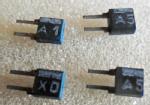
Miniplast-Diode
|
|
|||||||||||||||||||||||||||||||||
|
Hits: 2020 Replies: 0
Miniplast-Diode (Miniplast-Diode)
|
|
|
Aren van Waarde
27.Jun.14 |
1
Dear fellow radio enthusiasts (Herr Oskar Elm in particular), From Pollin Electronic I recently acquired a large number of Miniplast-diodes made in the former German Democratic Republic (DDR). According to mr.Elm, these components were produced by the Halbleiterwerk at Frankfurt an der Oder (thanks for this information!). My batch of diodes contained many different types. Out of curiosity I sorted them and performed some measurements. I made the following discoveries: 1. Besides the type of Miniplast-Diodes described by Mr.Elm, there exist also Miniplast-Zenerdiodes. My batch contained types for 8.2V, 9.1V, 11V, 12V, 15V, 16V and 18V. The type markings start with the voltage (e.g. 8.2) in a first row and a letter/number combination in a second row. Hooked them up to my homebrew zener tester and found out that the zener voltages were correct (and mostly quite accurate). 2. Other types which I acquired were labeled X5, W9, W3, WN, V0, R0, A5, or 30 followed by a two-letter combination. I initially suspected that they were capacitance diodes (varicaps) but this proved not true. When I hooked them up to my varicap tester (also homemade), they turned out to have very low capacitance values which were not voltage-dependent in the range of zero to 12 Volts. And surprisingly, the diodes which were marked 30 followed by a two-letter combination were NOT 30V zener diodes. 3. According to mr.Elm, the diodes from group 2 are low-voltage and low-current types which were employed as rectifiers in the power supply of frequency converters etc. The meaning of their side markings is currently unknown. Because of their low measured capacitance values, I wonder whether they may also have been used for (RF) switching purposes. Good luck with radio collection, homebrewing and repair! Aren van Waarde (Groningen, Netherlands)
|
End of forum contributions about this tube
| Data Compliance | More Information |

